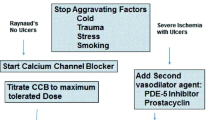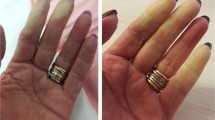Abstract
Although certain broad principles of treatment apply to all patients with Raynaud’s phenomenon, the exact approach will vary depending on the nature and severity of the underlying digital vascular problem. Advances in the understanding of the pathophysiology of Raynaud’s phenomenon are directing new lines of therapy. This review considers general (nonpharmacologic) measures, the different types of drug therapy, and the role of surgery. Recent advances in the use of more conventional treatments, such as calcium channel blockers, are discussed and also newer agents that are currently being researched, for example, endothelin-1 receptor antagonists and nitric oxide donors. The necessity of prompt assessment and treatment of acute digital ischemia, which is a medical emergency, is highlighted.
Similar content being viewed by others
References and Recommended Reading
Block JA, Sequeira W: Raynaud’s phenomenon. Lancet 2001, 357:2042–2048.
Harrison BJ, Silman AJ, Hider S, Herrick AL: Cigarette smoking: a risk factor for digital vascular complications in systemic sclerosis. Arthritis Rheum 2002, 46:3312–3316.
Sari-Kouzel H, Hutchinson CE, Middleton A, et al.: Foot problems in patients with systemic sclerosis. Rheumatology 2001, 40:410–413.
Raynaud’s Treatment Study Investigators: Comparison of sustained-release nifedipine and temperature biofeedback for treatment of primary Raynaud phenomenon: results from a randomized clinical trial with 1-year follow-up. Arch Intern Med 2000, 160:1101–1108. This five-center study of 313 patients with primary Raynaud’s phenomenon randomized into four treatment groups—temperature biofeedback, control biofeedback, sustained-release nifedipine, and placebo nifedipine, with evaluations at 2 months and 1 year. This is the first study to compare biofeedback with nifedipine, and to examine the efficacy and adverse effect profile of sustained-release nifedipine, in patients with primary Raynaud’s phenomenon.
Thompson AE, Shea B, Welch V, et al.: Calcium-channel blockers for Raynaud’s phenomenon in systemic sclerosis. Arthritis Rheum 2001, 44:1841–1847.
Sturgill MG, Seibold JR: Rational use of calcium-channel antagonists in Raynaud’s phenomenon. Curr Op Rheumatol 1998, 10:584–588.
Mancini GB, Henry GC, Macaya C, et al.: Angiotensin-converting enzyme inhibition with quinapril improves endothelial vasomotor dysfunction in patients with coronary artery disease. The TREND (Trial on Reversing ENdothelial Dysfunction) Study. Circulation 1996, 94:258–265.
Dziadzio M, Denton CP, Smith R, et al.: Losartan therapy for Raynaud’s phenomenon and scleroderma: clinical and biochemical findings in a fifteen-week, randomized, parallelgroup, controlled trial. Arthritis Rheum 1999, 42:2646–2655. This is the first clinical trial of an angiotensin II receptor antagonist in the treatment of Raynaud’s phenomenon. Twenty-five patients with primary Raynaud’s phenomenon and 27 with SSc were randomized to either losartan or nifedipine and a variety of outcome measures examined, including noninvasive vascular studies and circulating markers of endothelial function.
Dahlof B, Devereux RB, Kjeldsen SE, et al.: Cardiovascular morbidity and mortality in the Losartan Intervention For Endpoint reduction in hypertension study (LIFE): a randomized trial against atenolol. Lancet 2002, 359:995–1003.
Flavahan NA, Flavahan S, Liu Q, et al.: Increased alpha-2-adrenergic constriction of isolated arterioles in diffuse scleroderma. Arthritis Rheum 2000, 43:1886–1890. This physiologic study further implicates alpha2-adrenergic receptors in the pathogenesis of vascular spasm.
Chotani MA, Flavahan S, Mitra S, et al.: Silent alpha-adrenergic receptors enable cold-induced vasoconstriction in cutaneous arteries. Am J Physiol Heart Circ Physiol 2000, 278:H1075-H1083.
Teh LS, Manning J, Moore T, et al.: Sustained-release transdermal glyceryl trinitrate patches as a treatment for primary and secondary Raynaud’s phenomenon. Br J Rheumatol 1995, 34:636–641.
Khan F, Greig IR, Newton DJ, et al.: Skin blood flow after trandermal S-nitrosothio-acetylglucose. Lancet 1997, 350:410–411.
Tucker AT, Pearson RM, Cooke ED, Benjamin N: Effect of nitric-oxide-generating system on microcirculatory blood flow in skin in patients with severe Raynaud’s syndrome: a randomized trial. Lancet 1999, 354:1670–1675. A randomized, placebo-controlled, crossover study demonstrating the efficacy of a NO-generating system in patients with primary Raynaud’s phenomenon; increases in microvascular volume and flux (in terms of percentage increase from baseline) were similar in patients and healthy controls.
Anderson ME, Moore TL, Hollis S, et al.: Digital vascular response to topical glyceryl trinitrate, as measured by laser Doppler imaging, in primary Raynaud’s phenomenon and systemic sclerosis. Rheumatology 2002, 41:324–328.
Khan F, Litchfield SJ, McLaren M, et al.: Oral L-arginine supplementation and cutaneous vascular responses in patients with primary Raynaud’s phenomenon. Arthritis Rheum 1997, 40: 352–357.
Khan F, Belch JJF: Skin blood flow in patients with systemic sclerosis and Raynaud’s phenomenon: effects of oral L-arginine supplementation. J Rheumatol 1999, 26:2389–2394.
Freedman RR, Girgis R, Mayes MD: Acute effect of nitric oxide on Raynaud’s phenomenon in scleroderma. Lancet 1999, 354:739.
Yamamota T, Katayama I, Nichioka K: Nitric oxide production and inducible nitric oxide synthase expression in systemic sclerosis. J Rheumatol 1998, 25:314–317.
Cotton SA, Herrick AL, Jayson MIV, Freemont AJ: Endothelial expression of nitric oxide synthases and nitrotyrosine in systemic sclerosis skin. J Pathol 1999, 189:273–278.
Wigley FM, Wise RA, Seibold JR, et al.: Intravenous iloprost infusion in patients with Raynaud phenomenon secondary to systemic sclerosis. A multicenter, placebo-controlled, double blind study. Ann Intern Med 1994, 120:199–206.
Pope J, Fenlon D, Thompson A, et al.: Iloprost and cisaprost for Raynaud’s phenomenon in progressive systemic sclerosis (Cochrane Review). In The Cochrane Library. Oxford: Update Software; 2002.
Fishman AP: Pulmonary hypertension: beyond vasodilator therapy. N Eng J Med 1998, 338:321–322.
Stratton R, Shiwen X, Martini G, et al.: Iloprost suppresses connective tissue growth factor production in fibroblasts and in the skin of scleroderma patients. J Clin Invest 2001, 108:241–250.
Mittag M, Beckheinrich P, Haustein UF: Systemic sclerosisrelated Raynaud’s phenomenon: effects of iloprost infusion therapy on serum cytokine, growth factor and soluble adhesion molecule levels. Acta DermVenereol 2001, 81:294–297.
Scorza R, Caronni M, Mascagni B, et al.: Effects of long-term cyclic iloprost therapy in systemic sclerosis with Raynaud’s phenomenon: a randomized, controlled study. Clin Exp Rheumatol 2001, 19:503–508.
Badesch DB, Tapson VF, McGoon MD, et al.: Continuous intravenous epoprostenol for pulmonary hypertension due to the scleroderma spectrum of disease: a randomized, controlled trial. Ann Int Med 2000, 132:425–434. Although assessment of digital ischemia or ulceration was not a primary outcome measure, this study of 111 patients with moderate to severe pulmonary hypertension is the first to describe the effects of long-term, continuously infused epoprostenol on the severity of Raynaud’s phenomenon and on digital ulcer counts.
Black CM, Halkier-Sorensen L, Belch JJF, et al.: Oral iloprost in Raynaud’s phenomenon secondary to systemic sclerosis: a multicenter, placebo-controlled, dose-comparison study. Br J Rheumatol 1998, 37:952–960.
Wigley FM, Korn JH, Csuka ME, et al.: Oral iloprost treatment in patients with Raynaud’s phenomenon secondary to systemic sclerosis: a multicenter, placebo-controlled, double-blind study. Arthritis Rheum 1998, 41:670–677.
Vayssairat M: Controlled multicenter double-blind trial of an oral analogue of prostacyclin in the treatment of primary Raynaud’s phenomenon. French Microcirculation Society Multicentre Group for the Study of Vascular Acrosyndromes. J Rheumatol 1996, 23:1917–1920.
Vayssairat M: Preventative effect of an oral prostacyclin analog, beroprost sodium, on digital necrosis in systemic sclerosis. French Microcirculation Society Multicentre Group for the Study of Vascular Acrosyndromes. J Rheumatol 1999, 26:2173–2178.
Kirchengast M, Munter K: Endothelin-1 and endothelin receptor antagonists in cardiovascular remodeling. Proc Soc Exp Biol Med 1999, 221:312–325.
Vancheeswaran R, Azam A, Black C, Dashwood MR: Localization of endothelin-1 and its binding sites in scleroderma skin. J Rheumatol 1994, 21:1268–1276.
Channick RN, Simonneau G, Sitbon O, et al.: Effects of the dual endothelin-receptor antagonist bosentan in patients with pulmonary hypertension: a randomized placebo-controlled study. Lancet 2001, 358:1119–1123.
Rubin LJ, Badesch DB, Barst RJ, et al.: Bosentan therapy for pulmonary arterial hypertension. N Eng J Med 2002, 346:896–903.
Pope J, Fenlon D, Thompson A, et al.: Ketanserin for Raynaud’s phenomenon in progressive systemic sclerosis (Cochrane Review). In The Cochrane Library. Oxford: Update Software; 2002.
Coleiro B, Marshall SE, Denton CP, et al.: Treatment of Raynaud’s phenomemon with the selective serotonin reuptake inhibitor fluoxetine. Rheumatology 2001, 40:1038–1043.
Bunker CB, Reavley C, O’Shaughnessy DJ, Dowd PM: Calcitonin gene-related peptide in treatment of severe peripheral vascular insufficiency in Raynaud’s phenomenon. Lancet 1993, 342:80–82.
Herrick AL, Matucci Cerinic M: The emerging problem of oxidative stress and the role of antioxidants in systemic sclerosis. Clin Exp Rheumatol 2001, 19:4–8.
Denton CP, Bunce TD, Dorado MB, et al.: Probucol improves symptoms and reduces lipoprotein oxidation susceptibility in patients with Raynaud’s phenomenon. Rheumatology 1999, 38:309–315. The first controlled trial of antioxidant therapy in SSc. Although the authors stressed that results should be interpreted with caution, nonetheless their results suggest that further studies of antioxidants are warranted.
Herrick AL, Hollis S, Schofield D, et al.: A double-blind placebo-controlled trial of antioxidant therapy in limited cutaneous systemic sclerosis. Clin Exp Rheumatol 2000, 18:349–356.
Denton CP, Howell K, Stratton RJ, Black CM: Long-term low molecular weight heparin therapy for severe Raynaud’s phenomenon: a pilot study. Clin Exp Rheumatol 2000; 18:499–502.
Lakshminarayanan S, Maestrello SJ, Vazquez-Abad D, Waterman JR: Treatment of severe Raynaud’s phenomenon with ischemic ulcerations with tissue plasminogen activator. Clin Exp Rheumatol 1999, 17:260.
Johnson JP, Obasi MS, Hahn MS, Glatleider P: Endoscopic thoracic sympathectomy. J Neurosurg 1999, 91(suppl):90–97.
Yee AMF, Hotchkiss RN, Paget SA: Advential stripping: a digit saving procedure in refractory Raynaud’s phenomenon. J Rheumatol 1998, 25:269–276.
McCall TE, Petersen DP, Wong LB: The use of digital artery sympathectomy as a salvage procedure for severe ischemia of Raynaud’s disease and phenomenon. J Hand Surg 1999, 24:173–177.
Tomaino MM, Goitz RJ, Medsger TA: Surgery for ischemic pain and Raynaud’s phenomenon in scleroderma: a description of treatment protocol and evaluation of results. Microsurgery 2001, 21:75–79.
Klyscz T, Junger M, Meyer H, Rassner G: Improvement of acral circulation in a patient with systemic sclerosis with stellate blocks. Vasa 1998, 27:39–42.
Ho M, Veale D, Eastmond C, et al.: Macrovascular disease and systemic sclerosis. Ann Rheum Dis 2000, 59:39–43.
Susol E, MacGregor AJ, Barrett JH, et al.: A two-stage, genomewide screen for susceptibility loci in primary Raynaud’s phenomenon. Arthritis Rheum 2000, 43:1641–1646.
Author information
Authors and Affiliations
Rights and permissions
About this article
Cite this article
Herrick, A.L. Treatment of Raynaud’s phenomenon: New insights and developments. Curr Rheumatol Rep 5, 168–174 (2003). https://doi.org/10.1007/s11926-003-0046-0
Issue Date:
DOI: https://doi.org/10.1007/s11926-003-0046-0




